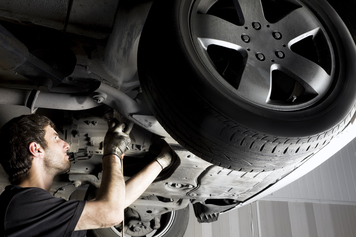Posted on 8/11/2015

We had a Volvo in a while back and when I drove the car into the shop I noticed that the brake pedal was very difficult to operate as there was no power assist for the brake system. I did a quick visual inspection and found a portion of the brake vacuum tubing damaged. Engine vacuum is a critical component in making your brakes work properly, and with this damaged line, there was quite a bit more foot effort required to stop the car. We asked the owner about this and found that the car had been to another shop and quite a bit of work had been done in an attempt to fix this to no avail. The next recommendation was to replace the brake rotors as it was felt that the rotors were glazed. Other common issues of carelessness we see: Sliding parts that don't get cleaned and lubricated. These parts are much more likely to seize and cause premature brake failure.
Brake pads and don't move easily on the pad bracket, causing brakes to drag.
Cheap rotors with too much lateral run ... read more
Posted on 7/8/2014

Drivers of import cars wince when they hit potholes. That is my observation driving in the company of countless European car owners, like those who own firm-on-the-road BMWs. Actually it is a good instinct to perceive bad road conditions as a risk in any season for luxury foreign cars, even for those owning higher-riding Lexus SUVs. Yet I have noticed that once a car keeps going, apparently handling a pothole peril, the driver relaxes, forgetting the possibility of harm to the car—after all, the sensitive foreign car is still performing, having survived the “ooch” factor. Subarus, for example, are designed to handle rough terrain. In reality, however, that initial instinct a driver has about the danger a pothole poses is accurate. Imported cars can and do suffer serious consequences from the unexpected hits to potholes and other rough road hazards. Foreign car owners may not realize their imported cars need service or repair. Even when there's no indication, maintenance checks ... read more